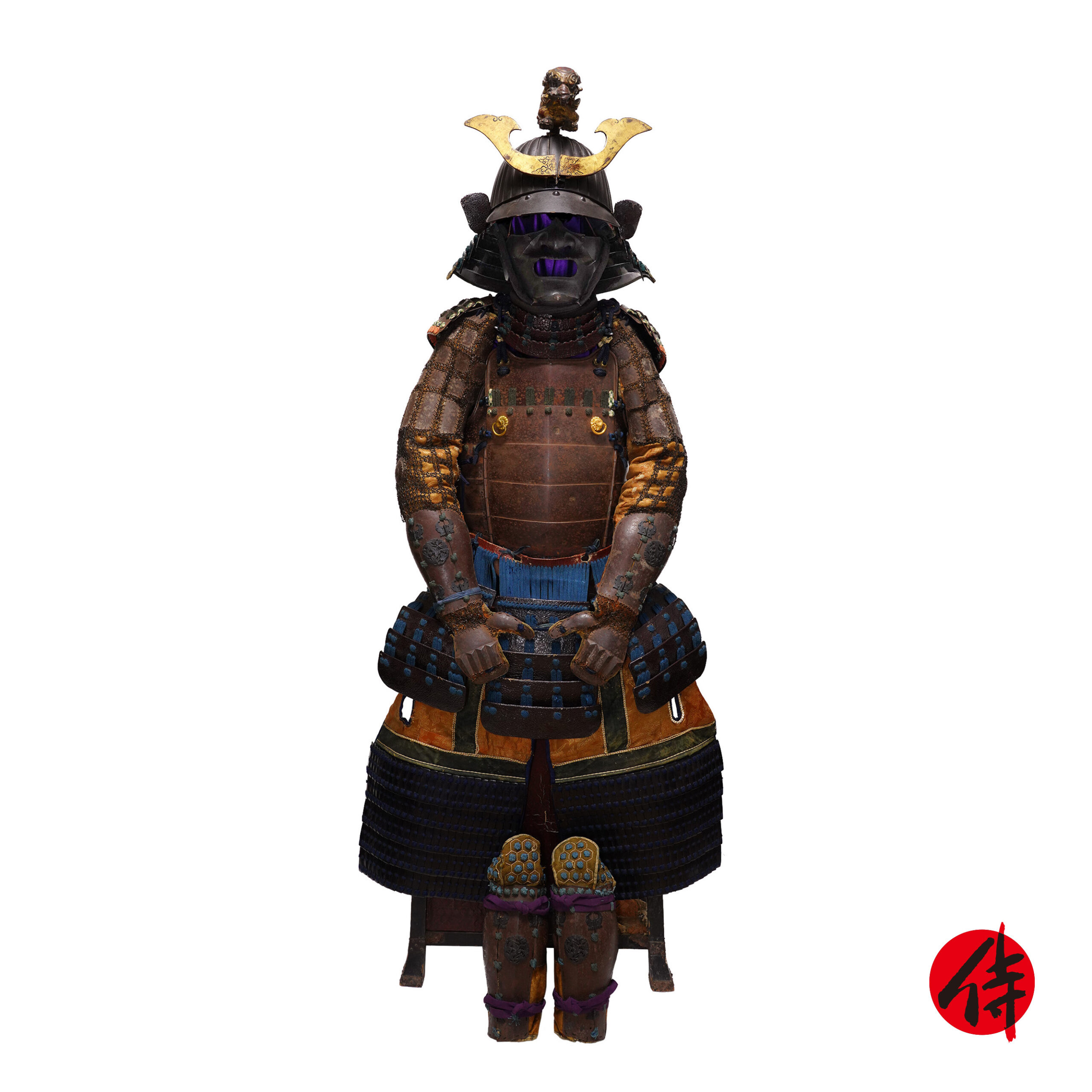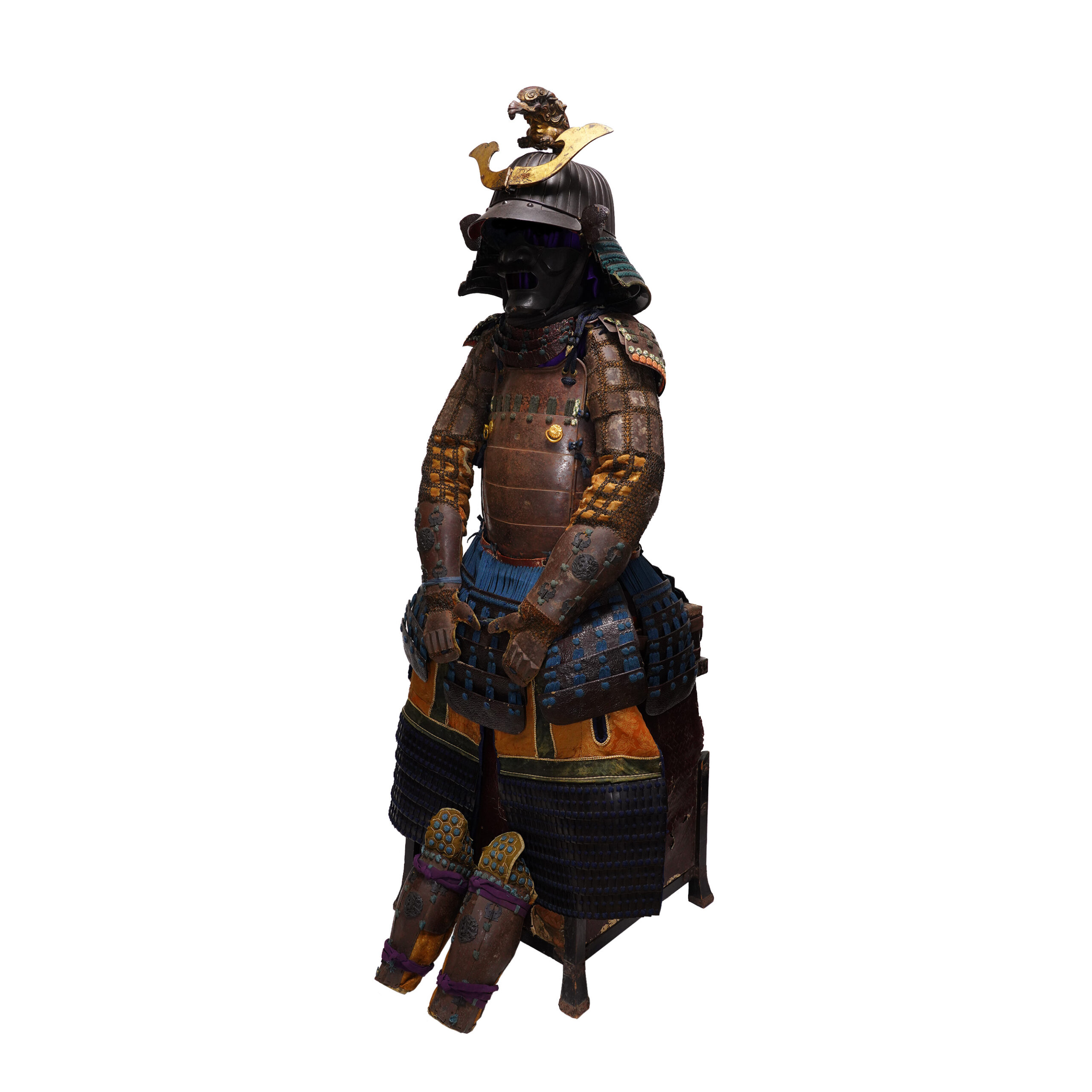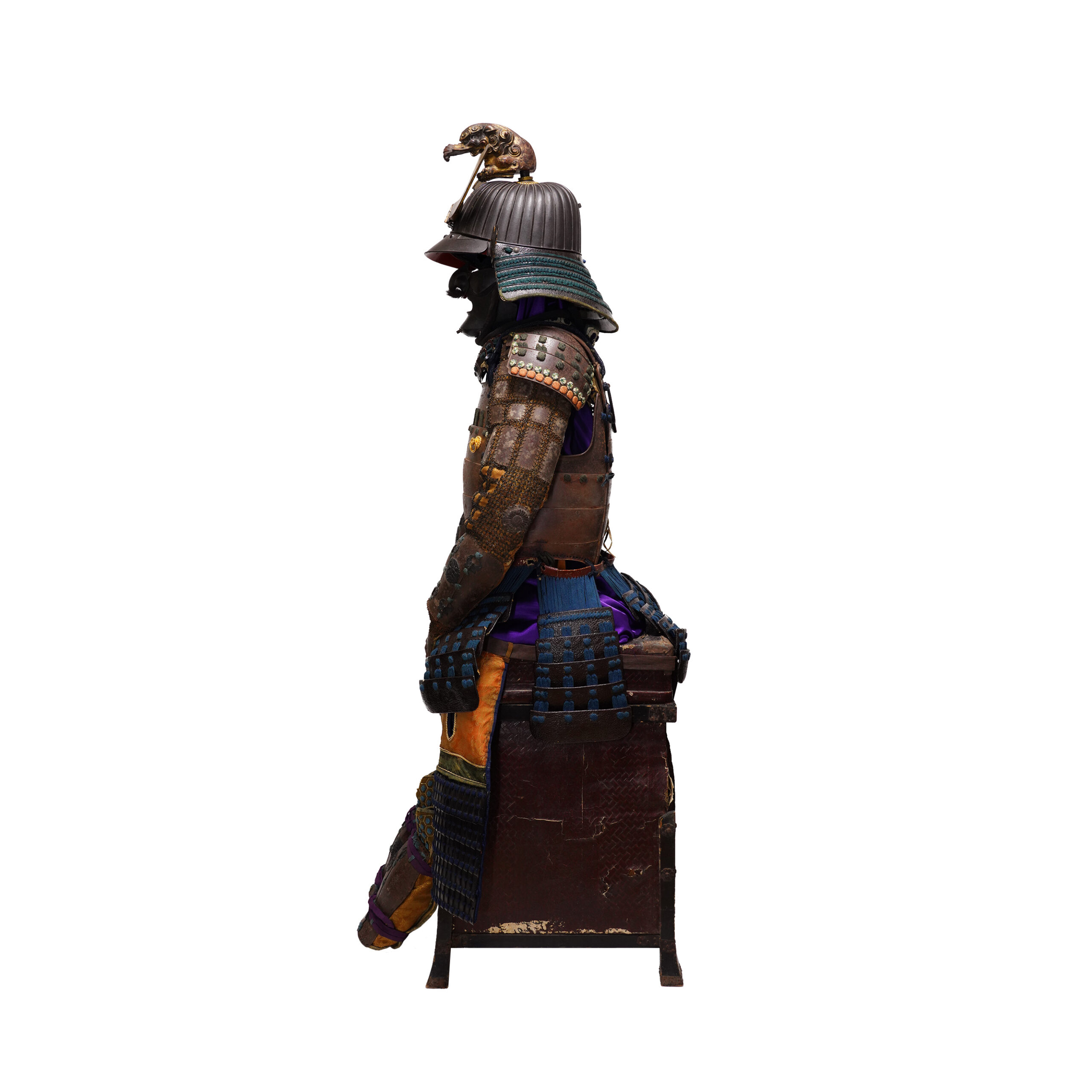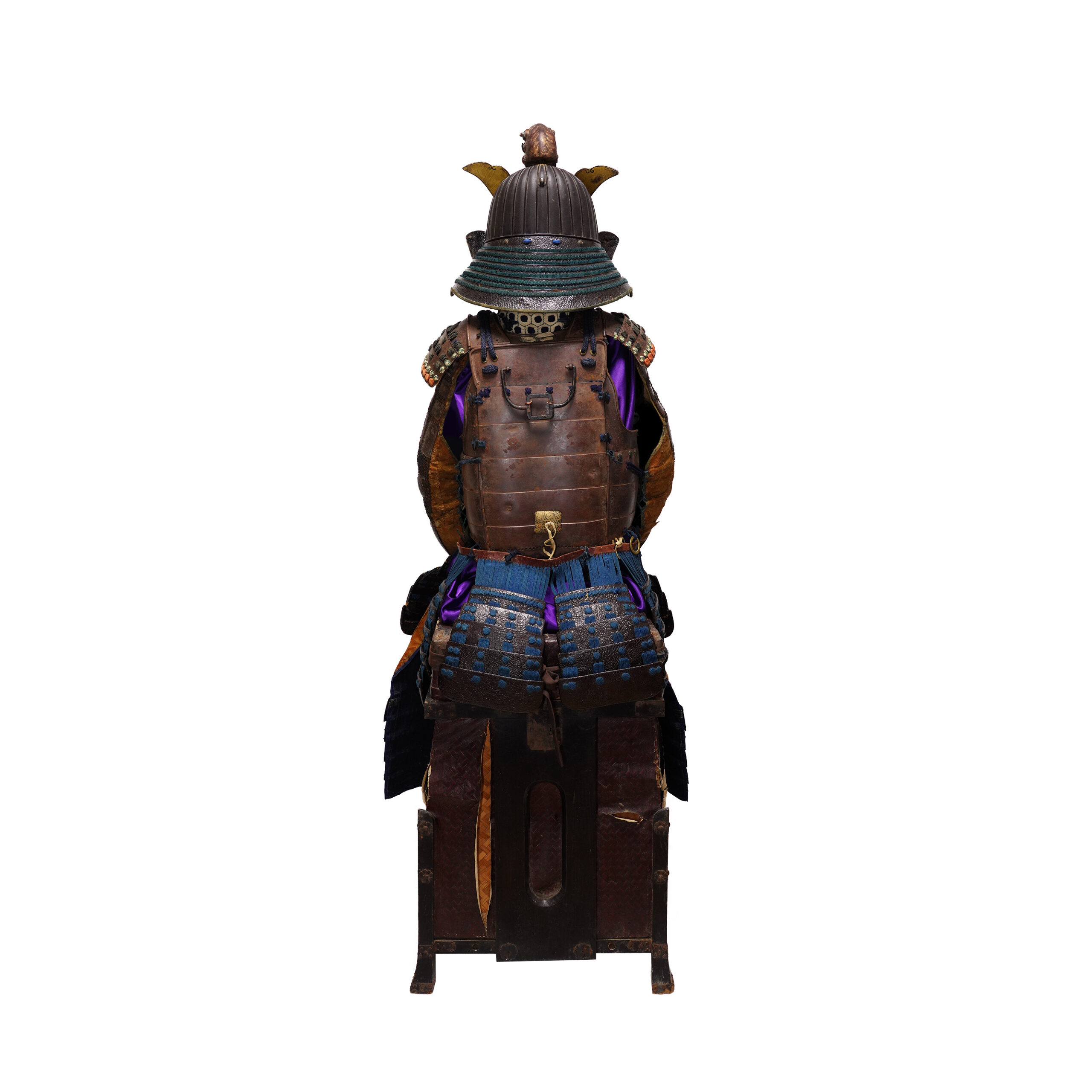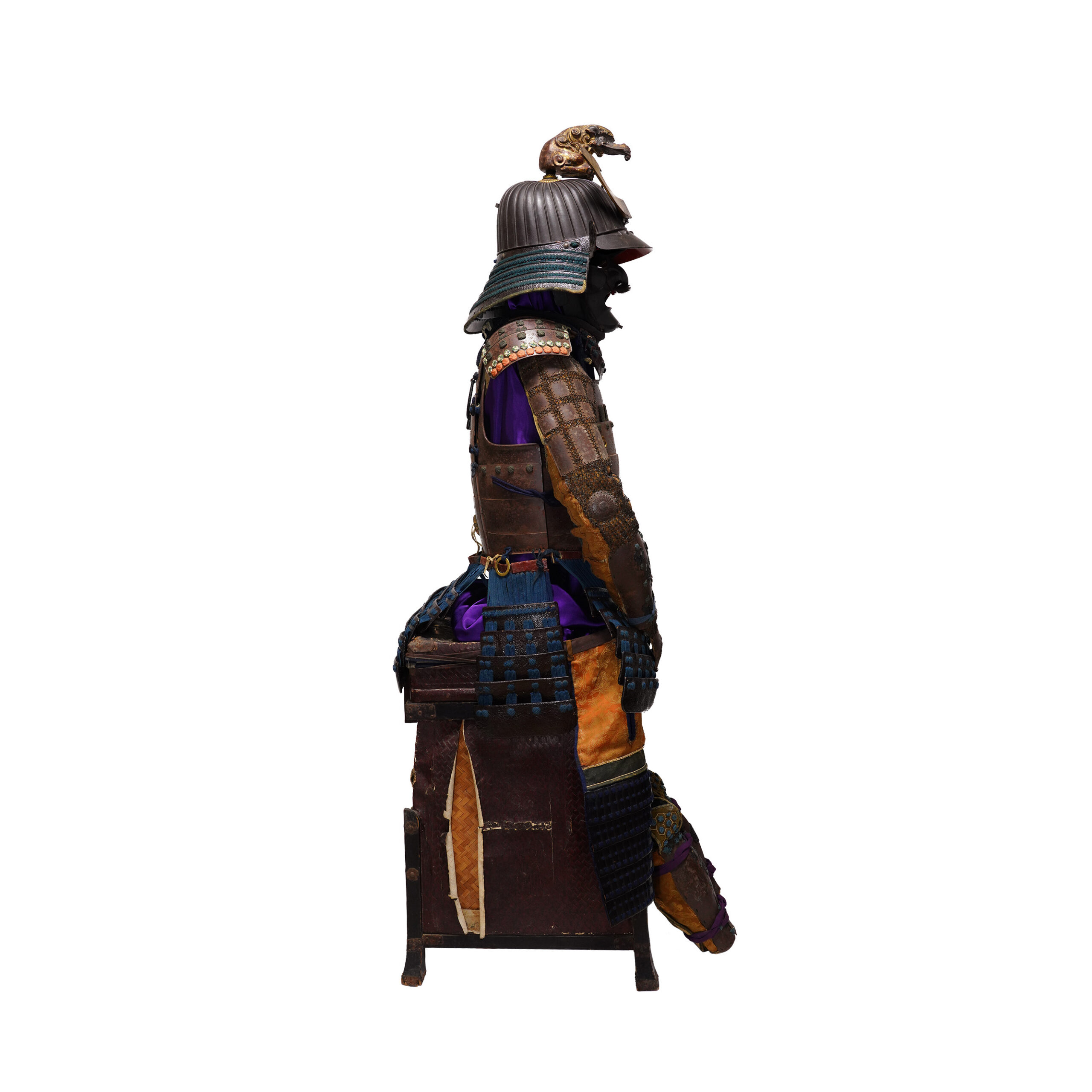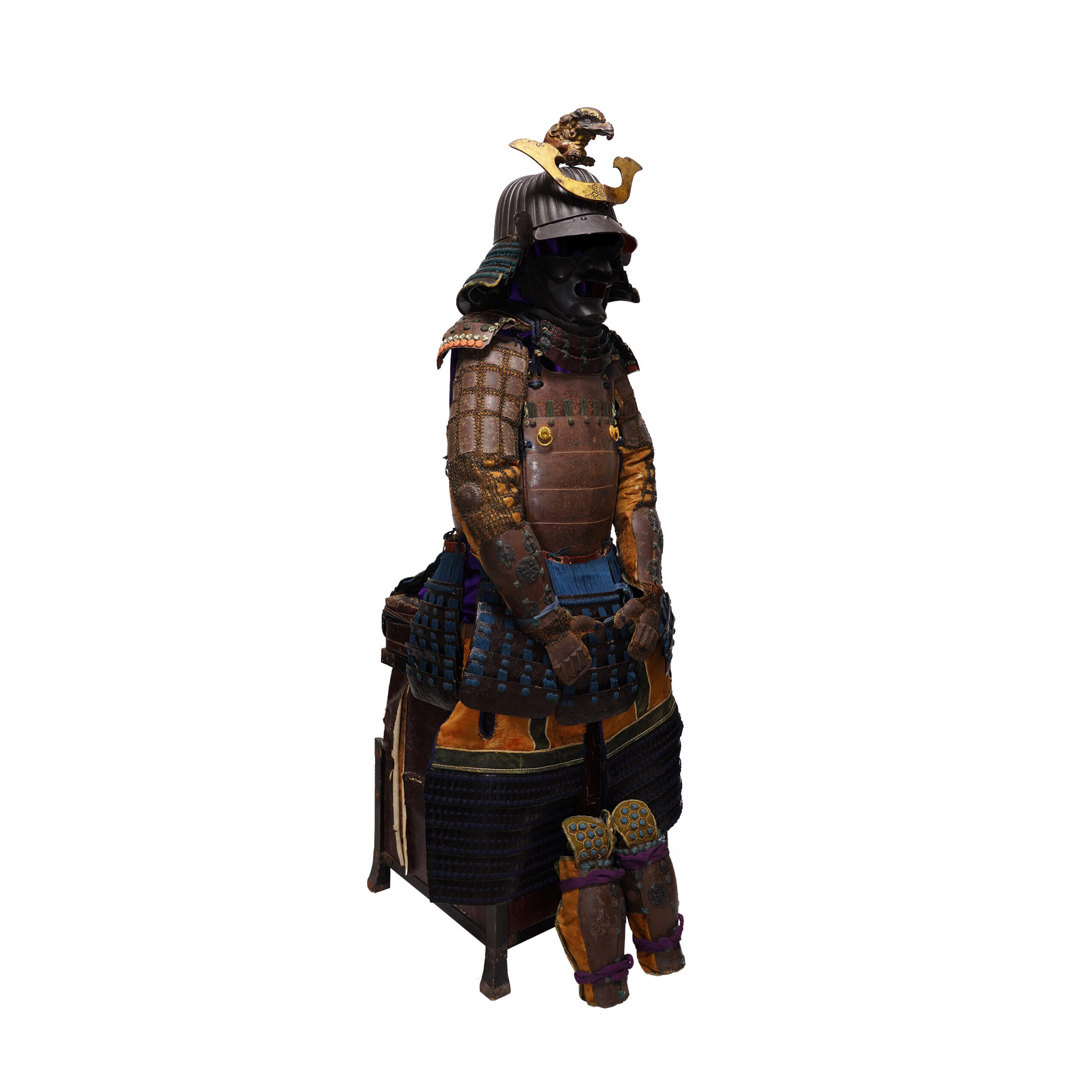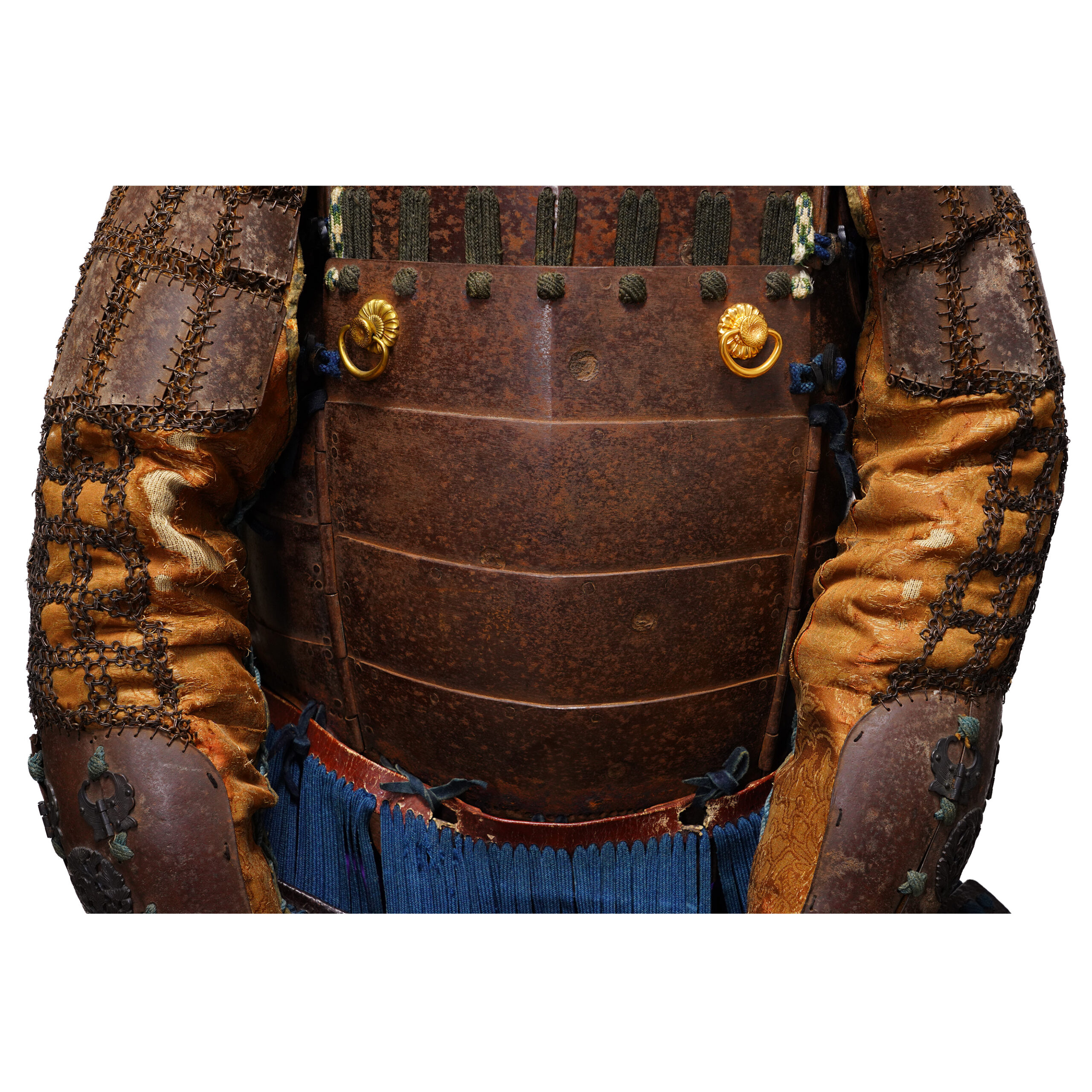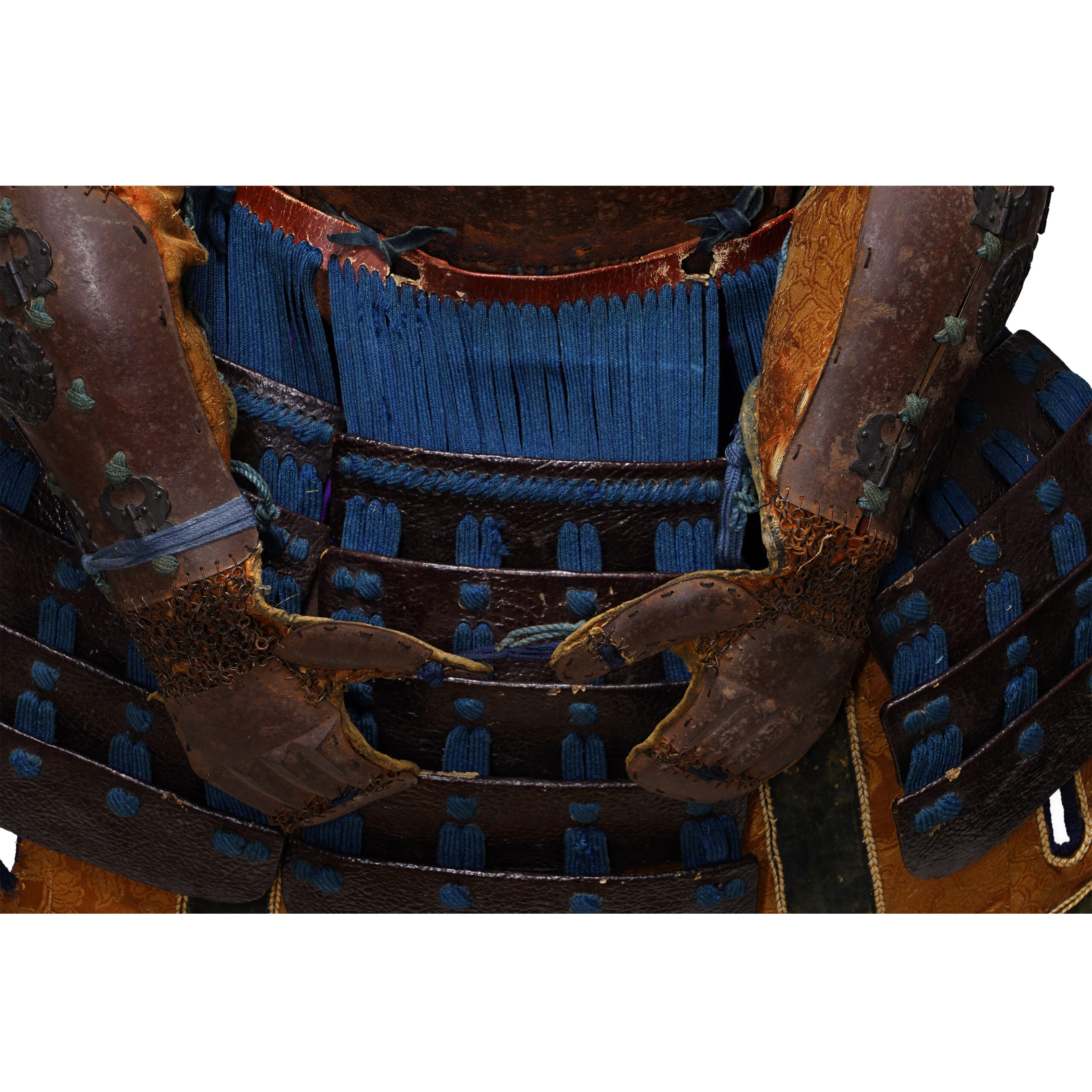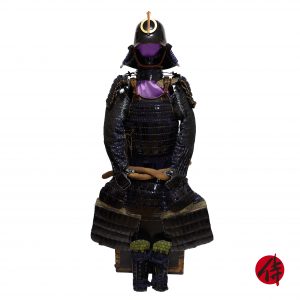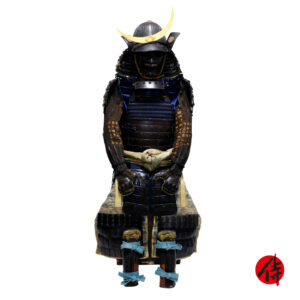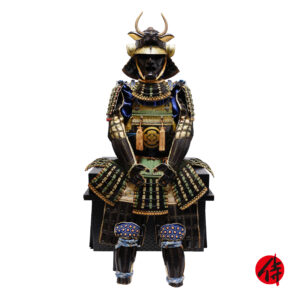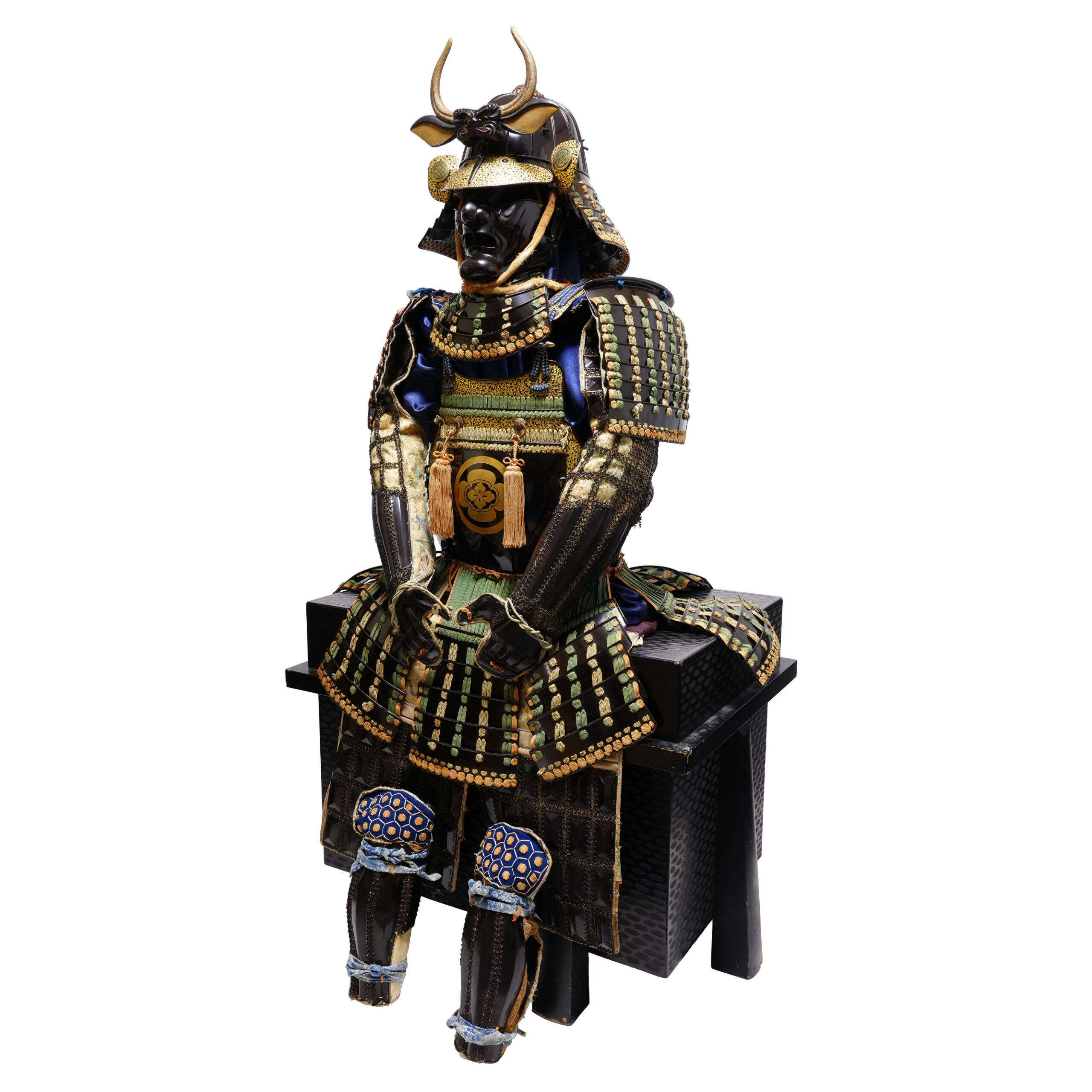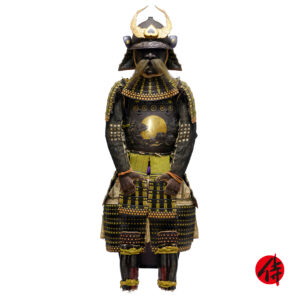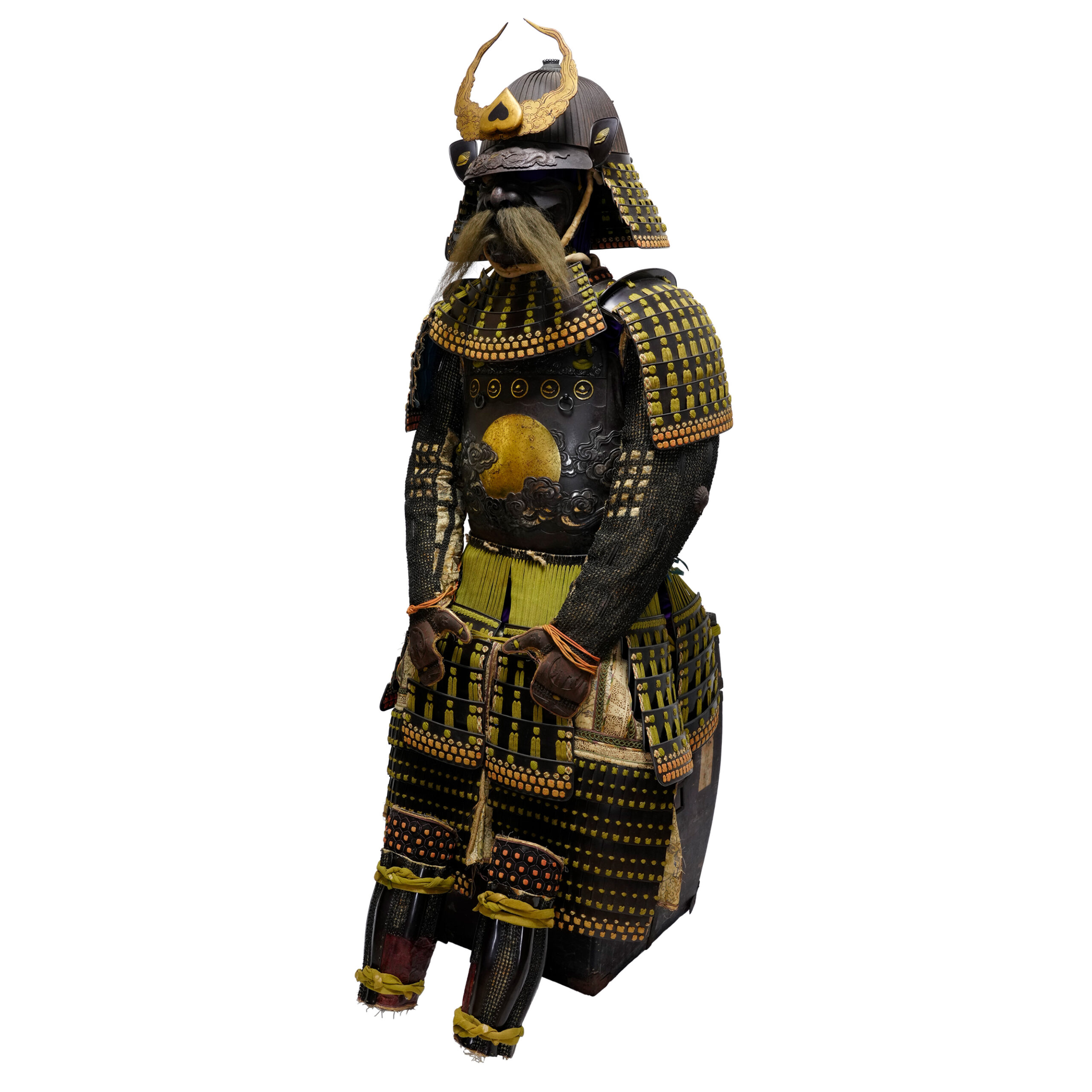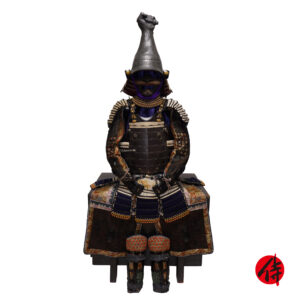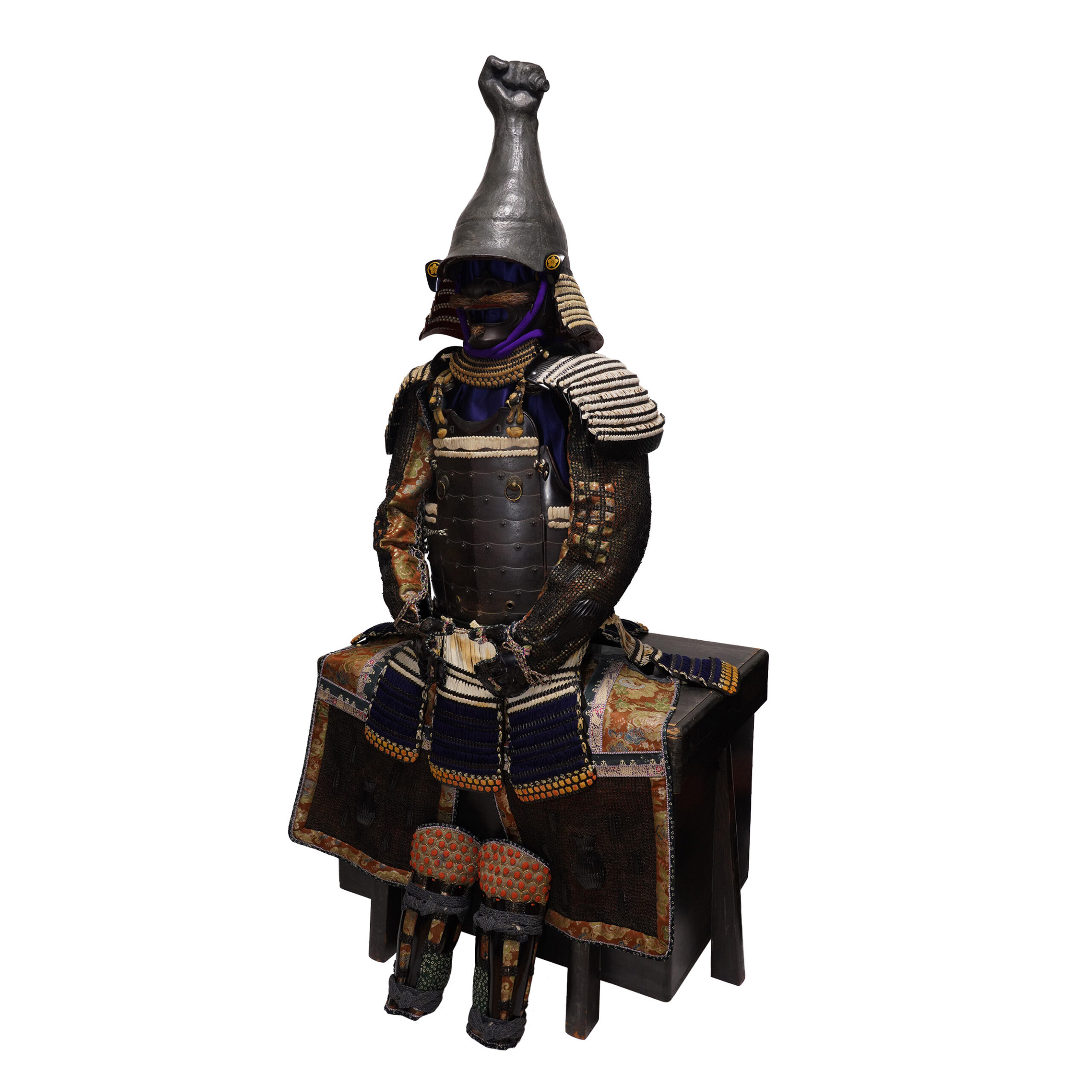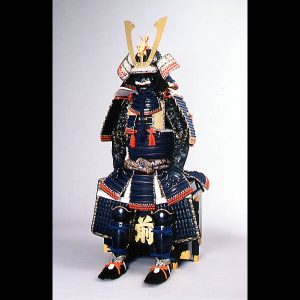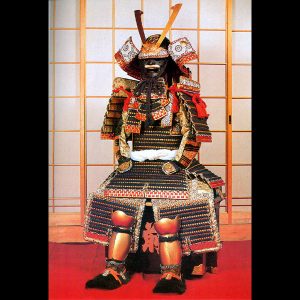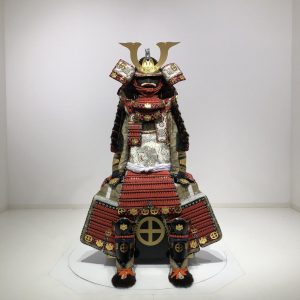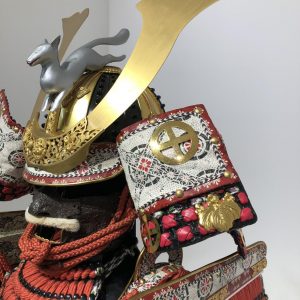Antique Edo Period Samurai Armor Tokubetsu Kicho Shiryo Certificate (A-26)
Period: Mid Edo Period
appraised by The Association for the Research and Preservation of Japanese Helmets and Armor
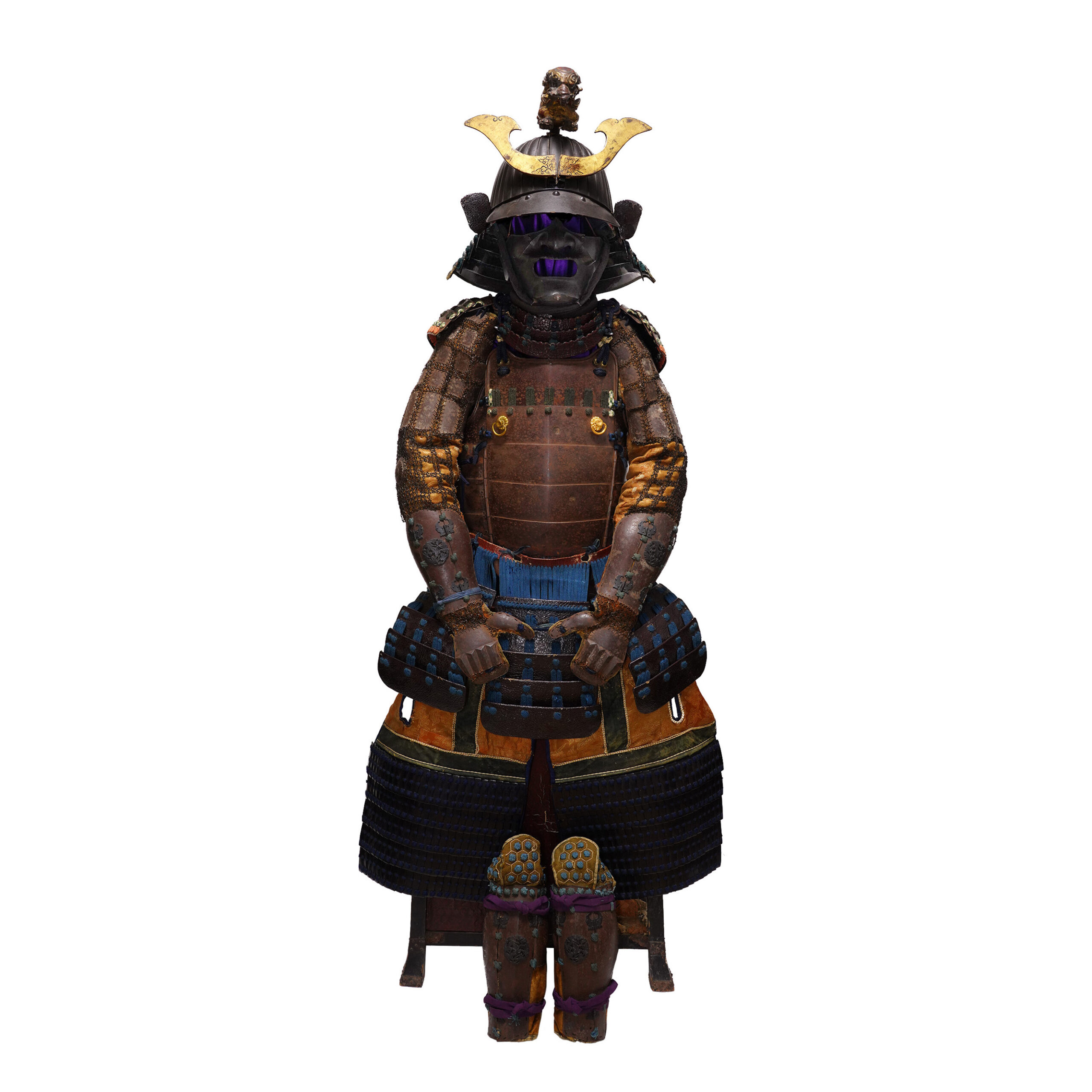
Kabuto (helmet)
■Helmet bowl: Suji Kabuto
The Kabuto (兜, helmet) is a protector for the head. When people started using the Kabuto, it was initially designed for practical use. However, the principal purpose of its design has changed with time; Samurais tried to express their dignity, personality, or religion by wearing the characteristic designed Kabutos. According to a theory, these unique designed Kabutos were made from the late Muromachi period to the Edo period. This type of Kabuto is categorized as the Kawari Kabuto (変わり兜), and a variety of materials were used to create them. For example, animal fur, seashells, plants, and papers were used as materials for decoration.
Here we would like to introduce to you a little bit more about the history of Kabutos. Before the Kawari Kabuto’s production, the Suji Kabuto (筋兜) has appeared during the Nanbokuchou (南北朝, 1337-1392) period. At that time, the tactic was gradually changed from the piggyback fight style to battle with the Tachi (太刀) sword and the Naginata (薙刀, Japanese halberd) on the ground. Therefore, there was a rise in demand for the weight-saving of the Kabuto. Also, in order to turn the attack by swords, a new type of structure was invented; it is the Suji Kabuto (筋兜). Its form slides swords’ attacks when weapons hit the Kabuto. It is said that the production of the Suji Kabuto prospered in the Muromachi (室町, 1336-1573) period. We estimate this Kabuto is one of these Suji Kabutos made in that tendency in the Edo period. It has 32 stripes in this Kabuto, meaning 32 small iron plates are connected. It is called Sanju Ni Ken Suji Kabuto (三十二間筋兜). Sanju Ni means 32 in Japanese. The surface is Tetsusabiji style, which only applied lacquer for paint base for the iron not to get rusty. It looks less shiny than a normal lacquered surface.
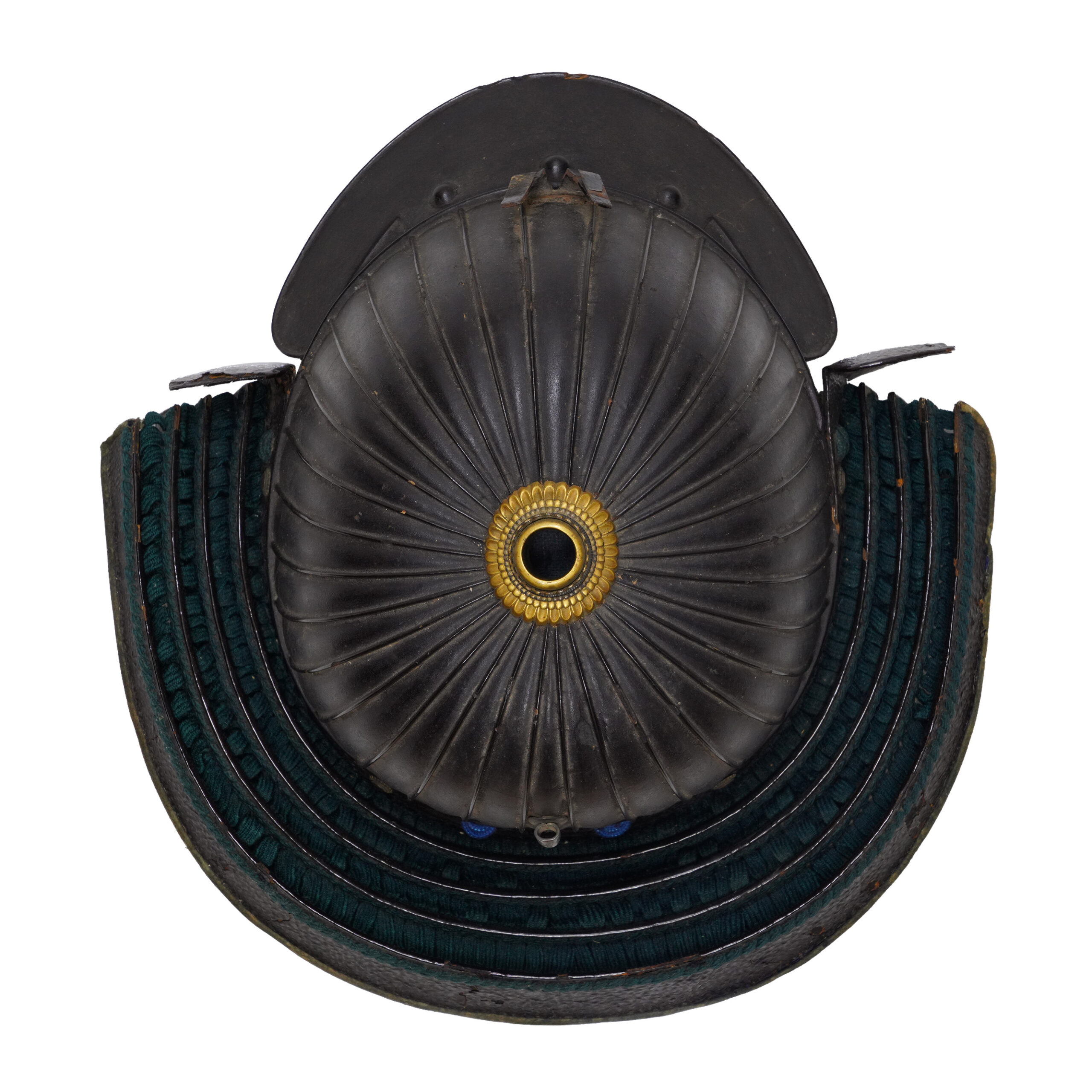
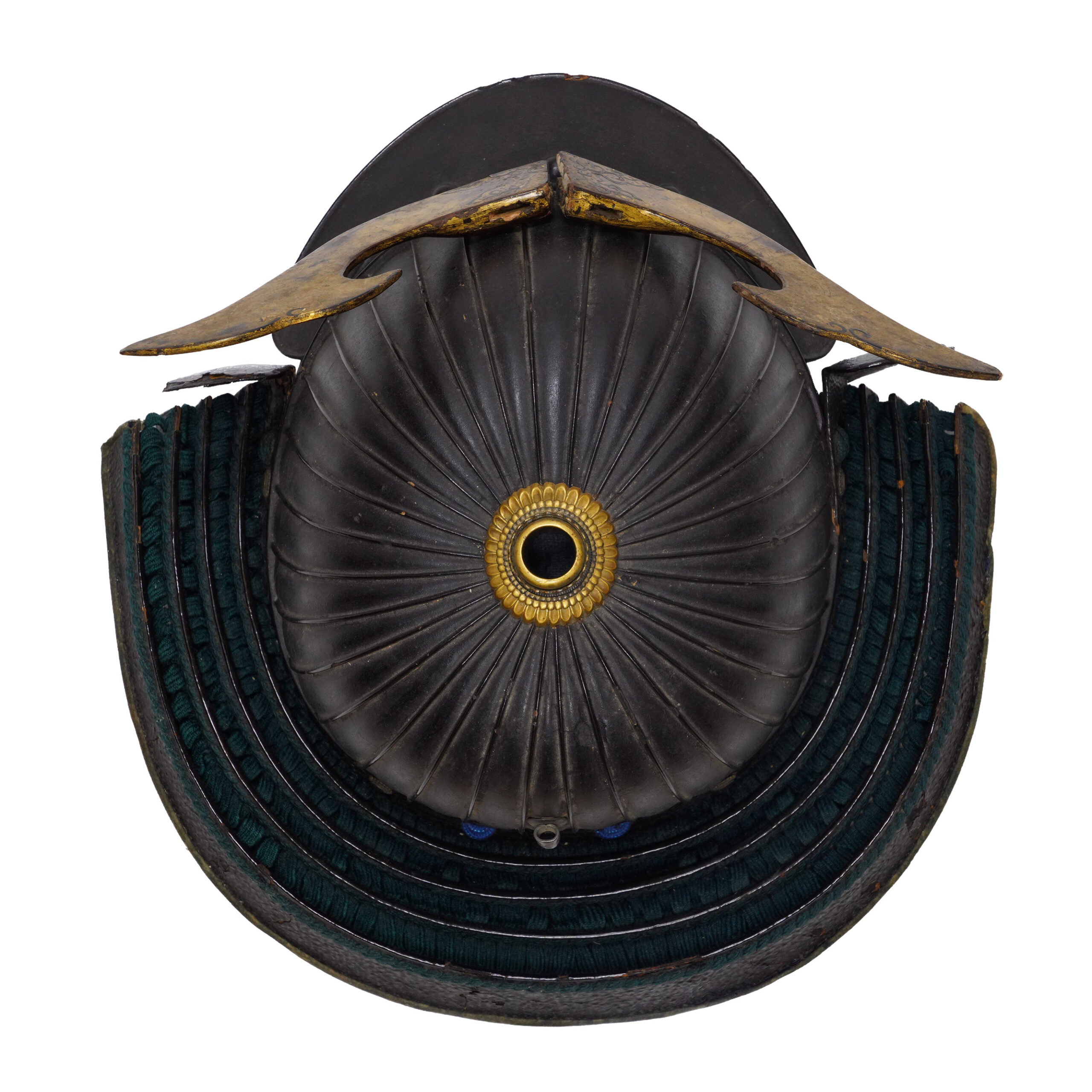
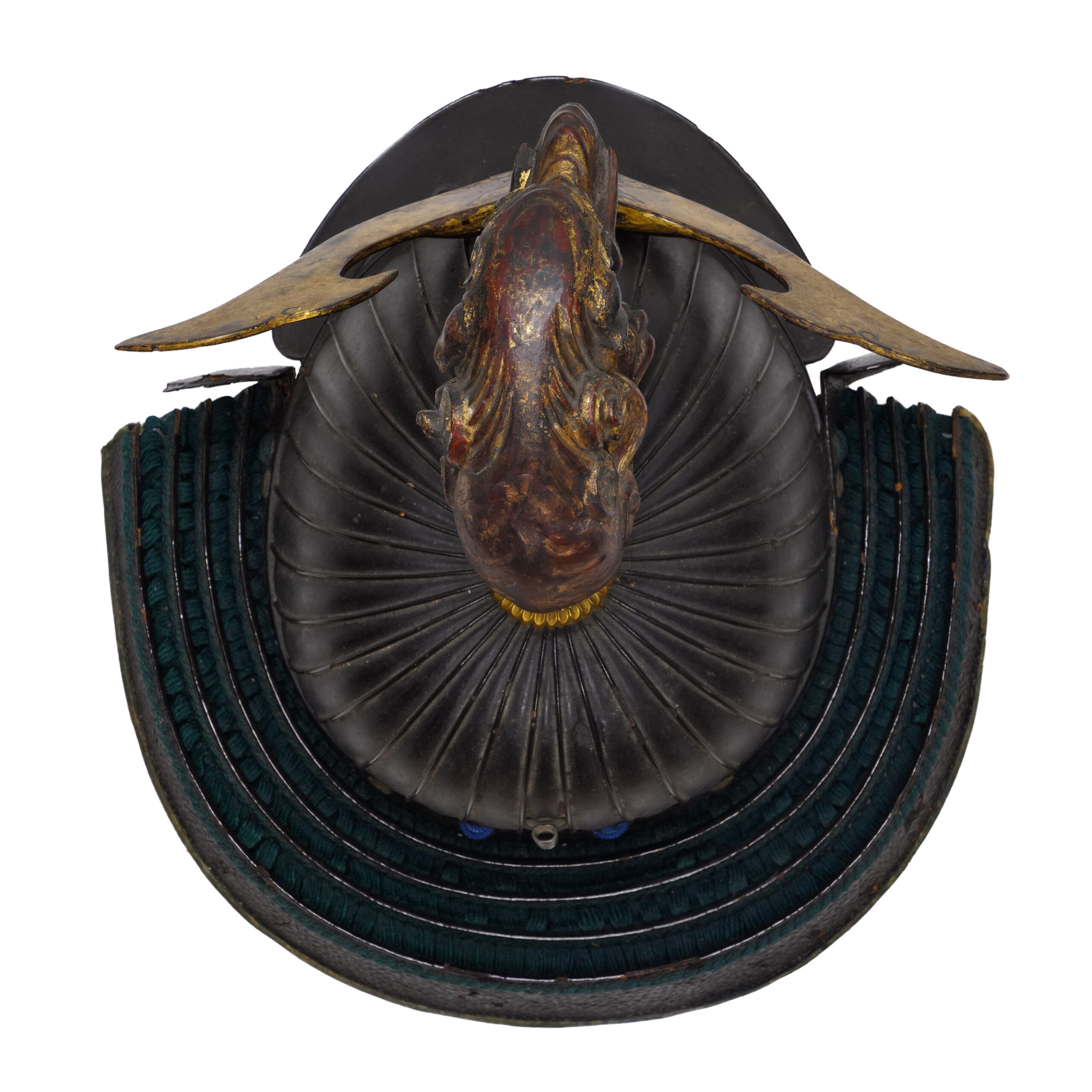
■Shikoro (side neck guard):
Iron plates laced with green threads.
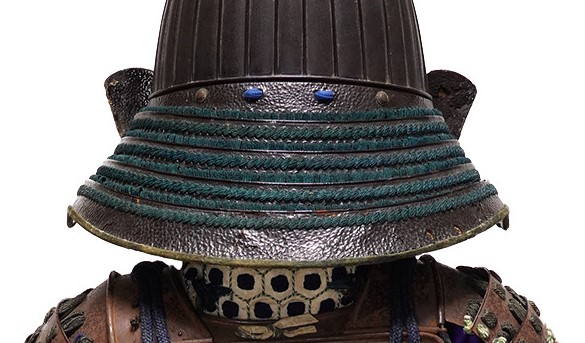
■Fukikaeshi (side neck guard):
The Fukikaeshi (吹き返し) is both ends of a Kabuto. It protects the face from swords and also shows its beautiful workmanship. Family crests are sometimes designed on this part. This Kabuto’s Fukikaeshi has a simple look.
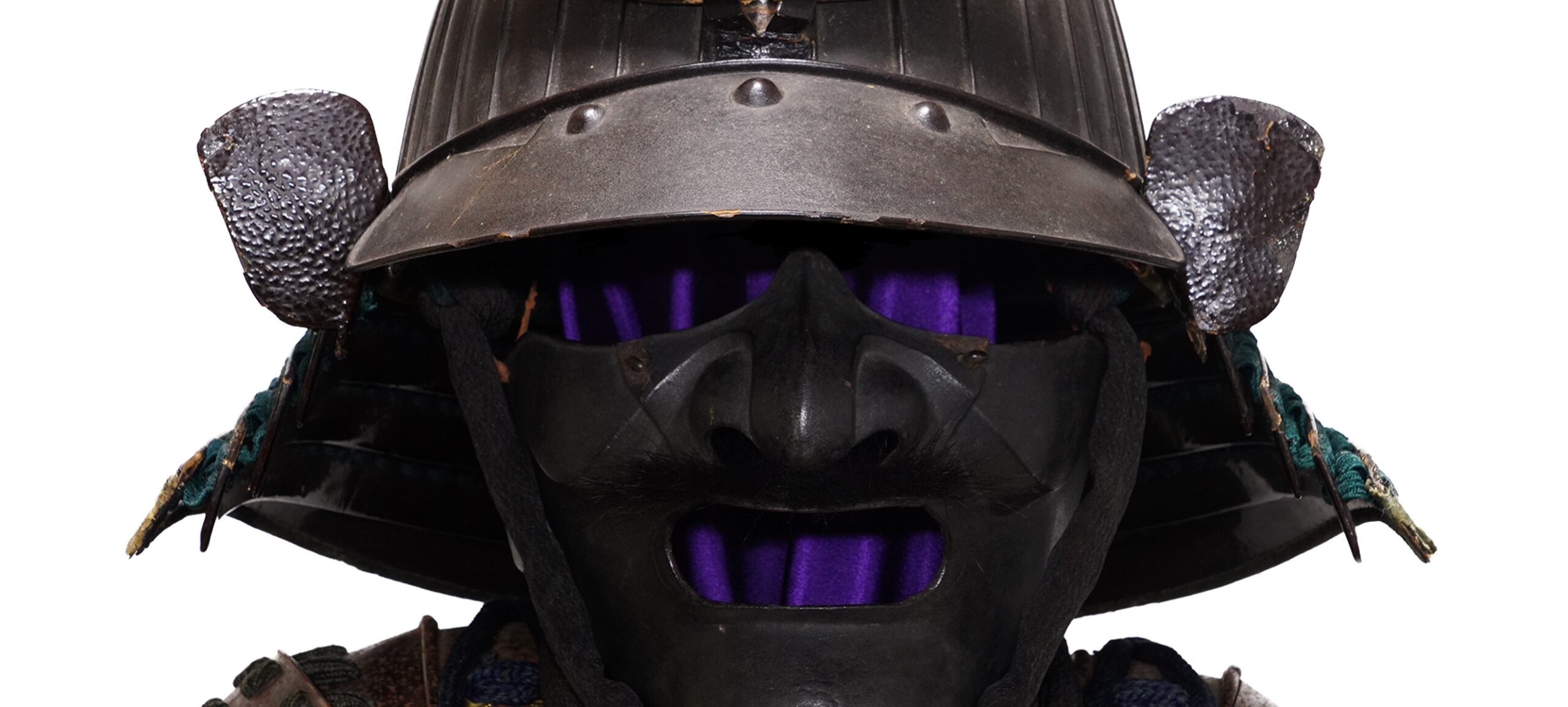
■Menpo (face guard): Ressei Menpo
Iron mask with a mustache. This type of Menpo is called the Ressei Menpo (烈勢面頬). It represents the angry face to intimidate enemies. There are many types of Menpo, depending on their shape or appearance. The purpose of Menpo was not only to protect Samurai’s face. But also to hide their true faces so that their psychological states were not affected.
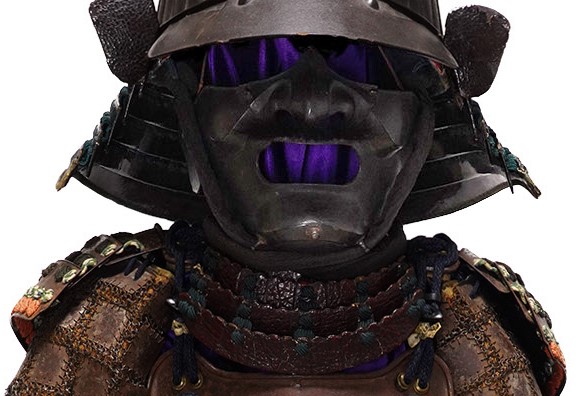
■ Kuwagata (Front decoration): Zou
The Kuwagata (鍬形) is attached to this helmet. It is a kind of Maedatemono (前立物, front decoration) to dignify the appearance. This Kabuto’s Kuwagata has a shape in which its tip is bifurcated. It is made of two plates and is colored with golden paint. Although there are minor damages, such as scratches, these are traces of its long history. We hope you will enjoy it as an antique texture.
An animal-shaped decoration is attached to the Tehen (天辺). Tehen/天辺の穴 (also called the Tehen-no Ana) is a hole at the top of the Kabuto. The metal fittings around this hole and the whole spot are called the Hachiman Za (八幡座). These are not provided simply to enhance decorativeness. It was believed that gods descended from heaven to this place to protect those who wore Kabuto. In other words, it was believed that god entered into this hole. Therefore, the Hachiman Za is a holy place.
Also, a Kabuto itself does not have air permeability, so the Tehen had a functional role in keeping it from getting stuffy. It takes a lot of time and effort to make a hole in the top of the Kabuto. Several processes must be followed, such as assembling the parts accurately and adding decorations around the holes. There are many Kabutos without this hole, depending on the era and the trend of the time. But you could see it in this Kabuto. In addition, as mentioned above, a kind of animal design ornament is installed in the Tehen. We are still determining what animal this creature is. We estimate it models an elephant. Here we introduce the history of elephants to you. Two elephants were brought to Japan from the continent in the Edo period, the 13th year of the Kyouho (享保) era (1728). They were gifts for the Tokugawa Shogun at that time, Tokugawa Yoshimune (徳川 吉宗, 1684-1751). Many ordinary people saw this animal during the journey from the elephant’s arrival to Edo city. And this giant animal became a trend among people. Initially, the Hakuzou (白象, white elephant) was sacred in Buddhism. It is known as a vehicle of the Fugen Bosatsu (普賢菩薩, Samantabhadra, a bodhisattva of rationale and mercy). A theory says Mayabunin (摩耶夫人, Mahāmāyā), who is the Buddha’s birth mother, saw a white elephant when she got pregnant Buddha. Also, the elephant has been regarded as a patient animal. Based on this history and religious idea, it is understandable that the elephant motif was incorporated into motifs for various items, as seen in this work.
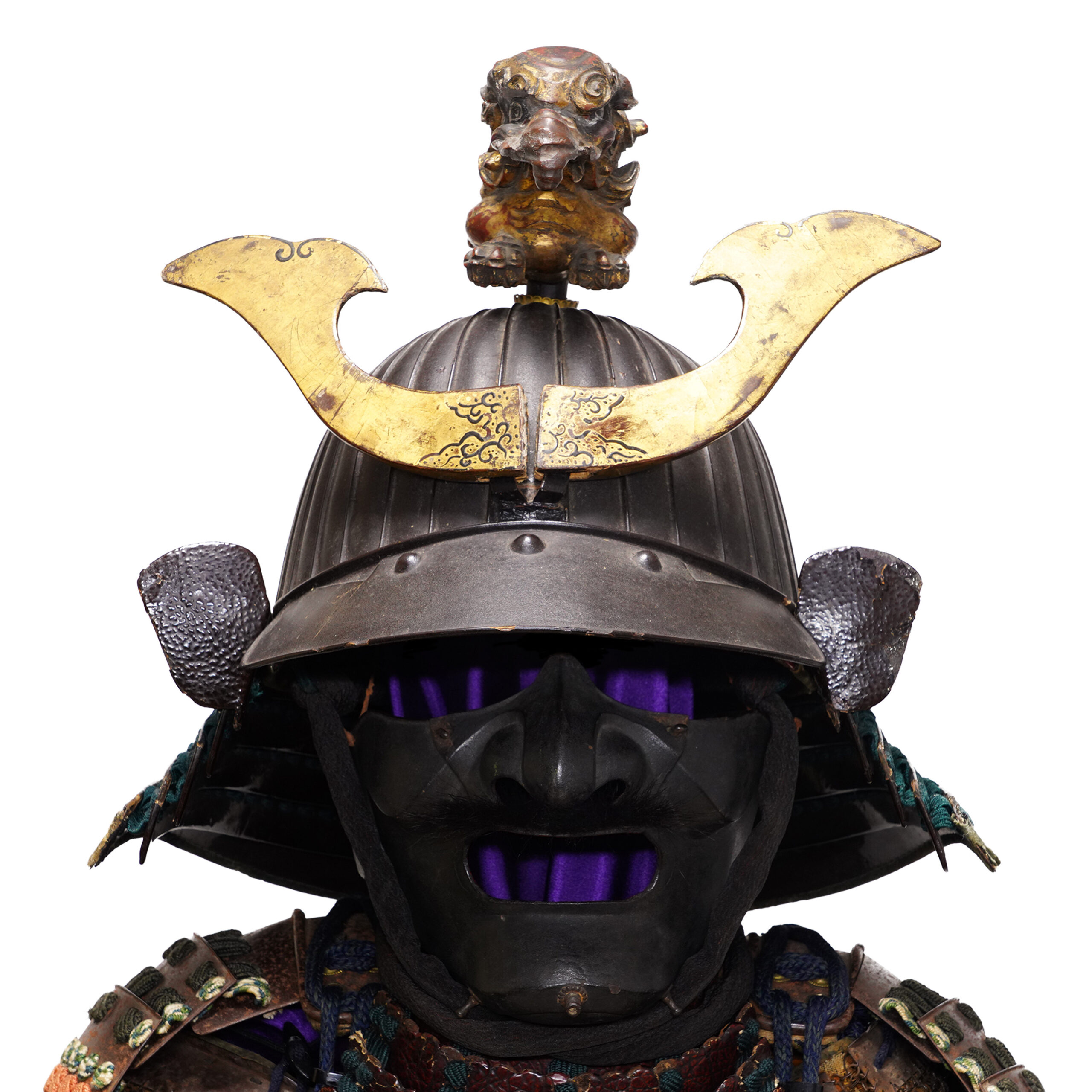
Armor
■Do (cuirass): Okegawa Nimai Do
Nimai Do (二枚胴) is a kind of cuirass for the Tousei Gusoku (当世具足, developed armor style). Nimai Do (二枚胴) was named because Nimai (二枚) means two plates, and Do (胴) means torso in Japanese. Instead of using a large number of small lamellar plates called Kozane (小札), this cuirass used large iron plates riveted.
The name Okegawa (桶側) came from the fact that the shape of this cuirass resembles the Gawa (側, side) of Oke (桶, Japanese wooden tub). The body armor part can be separated into two pieces and connected with a hinge. Generally, a hinge is located on the left side, and you could tighten a cuirass on the right side. The Okegawa Do was relatively easy to make and had high strength; therefore, it is said this style of cuirass became popular in the latter half of the Muromachi (室町, 1336-1573) period.
■Kusazuri (skirt of plates attached to the cuirass):
Lacquered iron Kusazuri laced with blue threads.
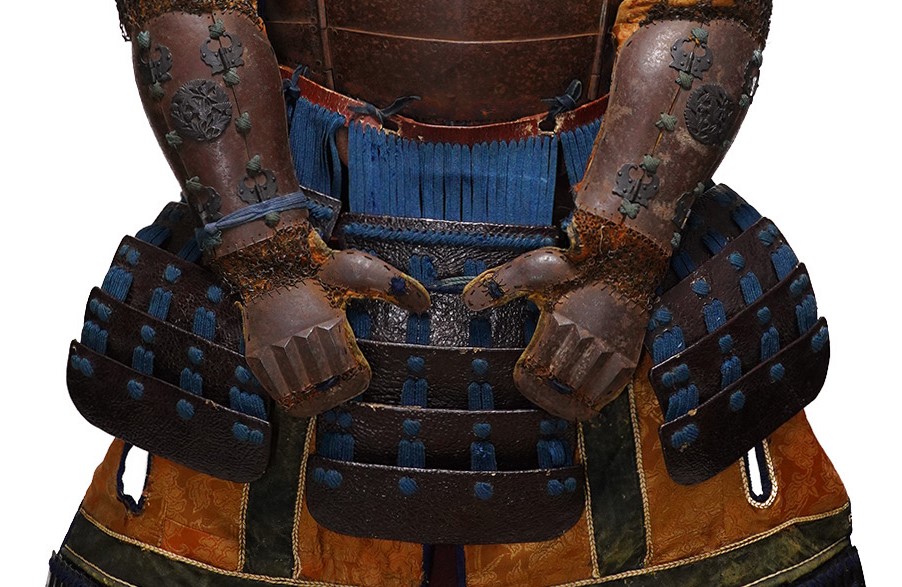
Small parts
■Kote (armored sleeves):
Intricate iron chain mail with silk.
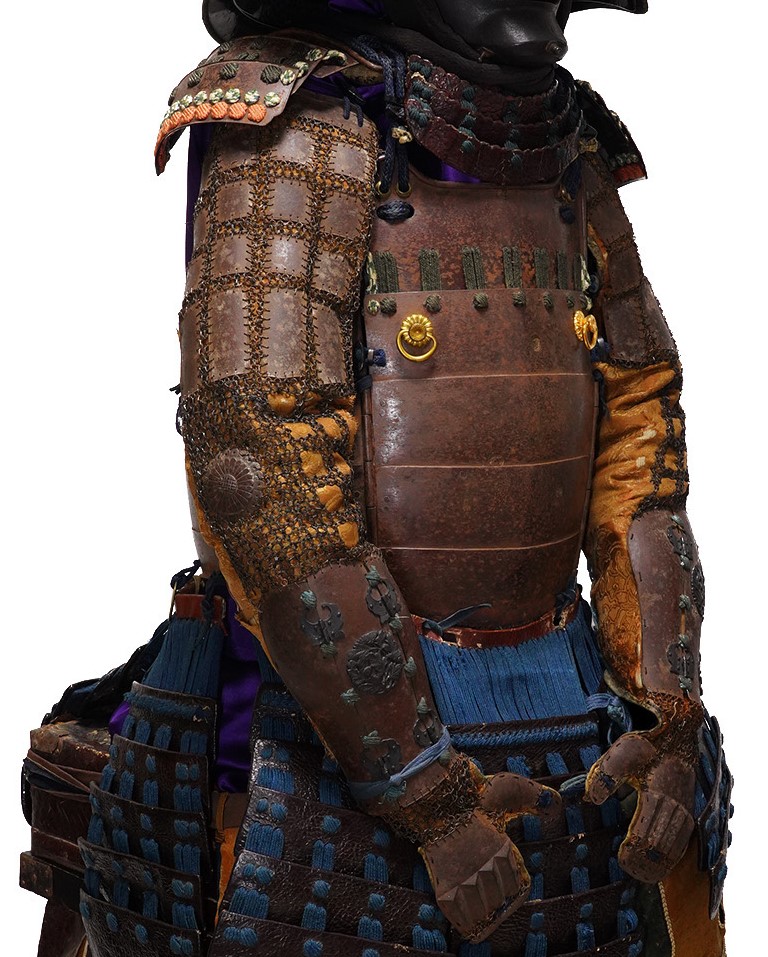
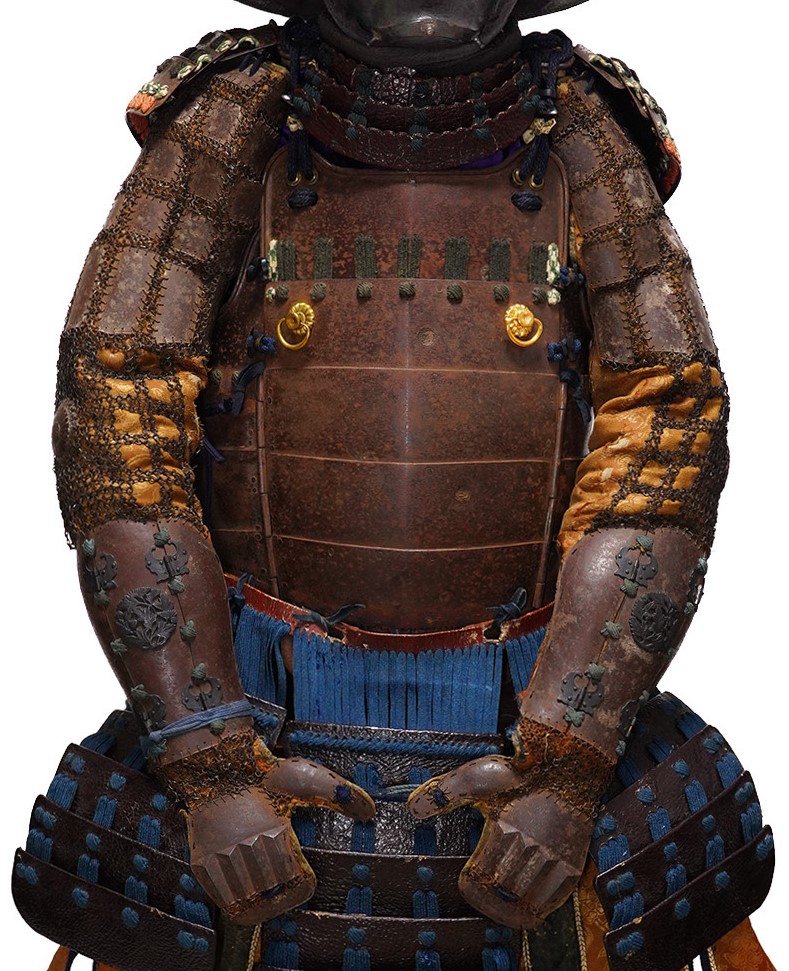
■Haidate (thigh protection):
The Haidate (佩楯) is a thigh guard. Many small rectangular black metal plates are tied together with blue color threads. The flower pattern designed on the vermilion cloth is probably the Botan (牡丹, peony) design. Peony represents happiness, wealth, nobleness, and gorgeousness. This flower pattern has been treated as a good-omen motif; people regarded it as a rich harvest sign. Its graceful appearance has attracted people since ancient times.
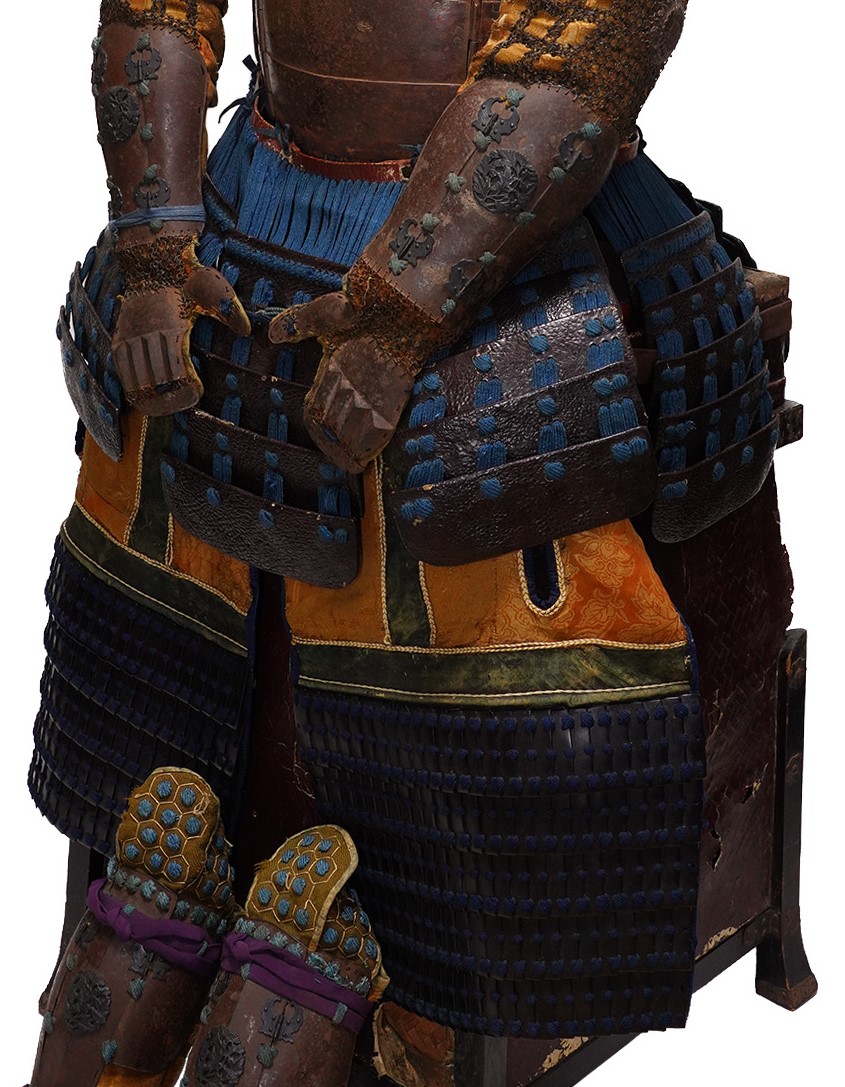
■Suneate (shin guard):
The Kikkou (亀甲, turtle’s shell) pattern is used for the cloth of the Suneate (脛当). It is a continuous geometric pattern connecting regular hexagons up and down. A theory says that this design was brought from China and the Korean Peninsula during the Asuka (飛鳥, 592-710) and Nara (奈良, 710-794) periods. A proverb says turtles live long lives; therefore, turtle and turtle shell patterns represent longevity. In addition, as this continuous hexagonal pattern does not get out of its shape, it is said people wished for eternal prosperity by using this design.
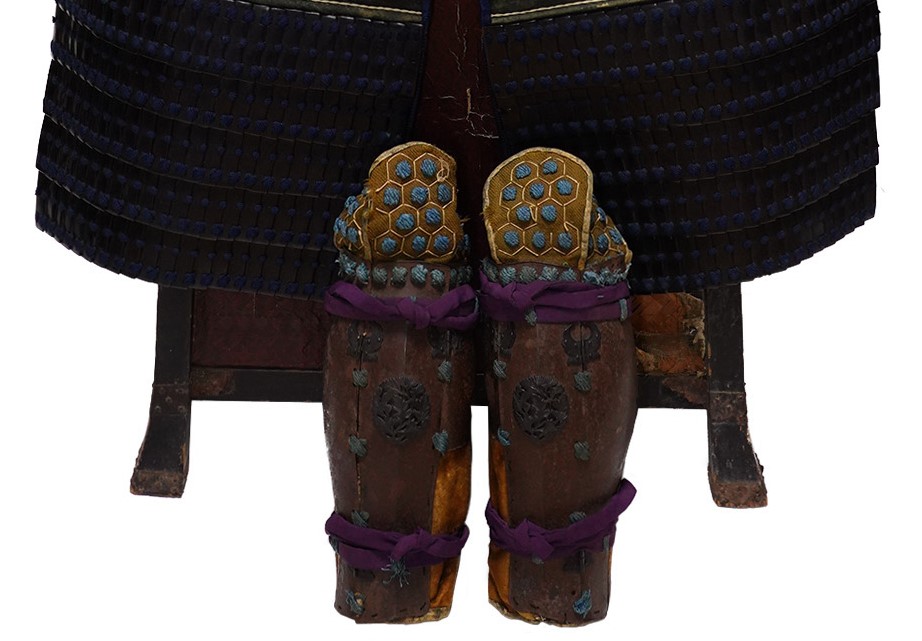
■Gattari (Sashimono holder):
If you focus on the back of this armor, you will find that a square-shaped metal frame is attached. It is a gear called the Gattari (合当理) that supports the upper part of the Sashimono (指物, a frag or decorative sign installed at the back of armor). Samurai warriors judged their sides and enemies on the battlefields by checking the motifs designed for flags. Especially in group battles with infantry, this method was very effective because they could instantly identify affiliations.
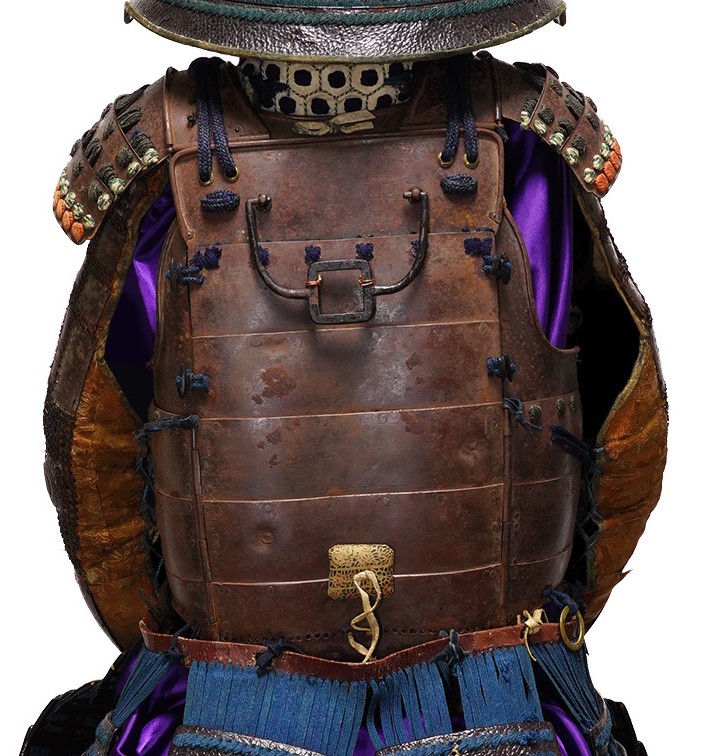
Certification: Tokubetsu Kicho Shiryo Certificate (No. 1998)
On November 6th 2022, this armor was appraised as a Tokubetsu Kicho Shiryo by The Association for the Research and Preservation of Japanese Helmets and Armor, which is the most trusted Japanese armor appraiser in Japan. Tokubestu Kicho Shiryo means special rare article. It is ranked as the third highest of five rankings.
The paper mentions the armor was made in the mid Edo period (late 17th- early 18th century). You can receive this original authentication paper.
An English translation of the certificate is available on request. We won’t charge any additional fee.
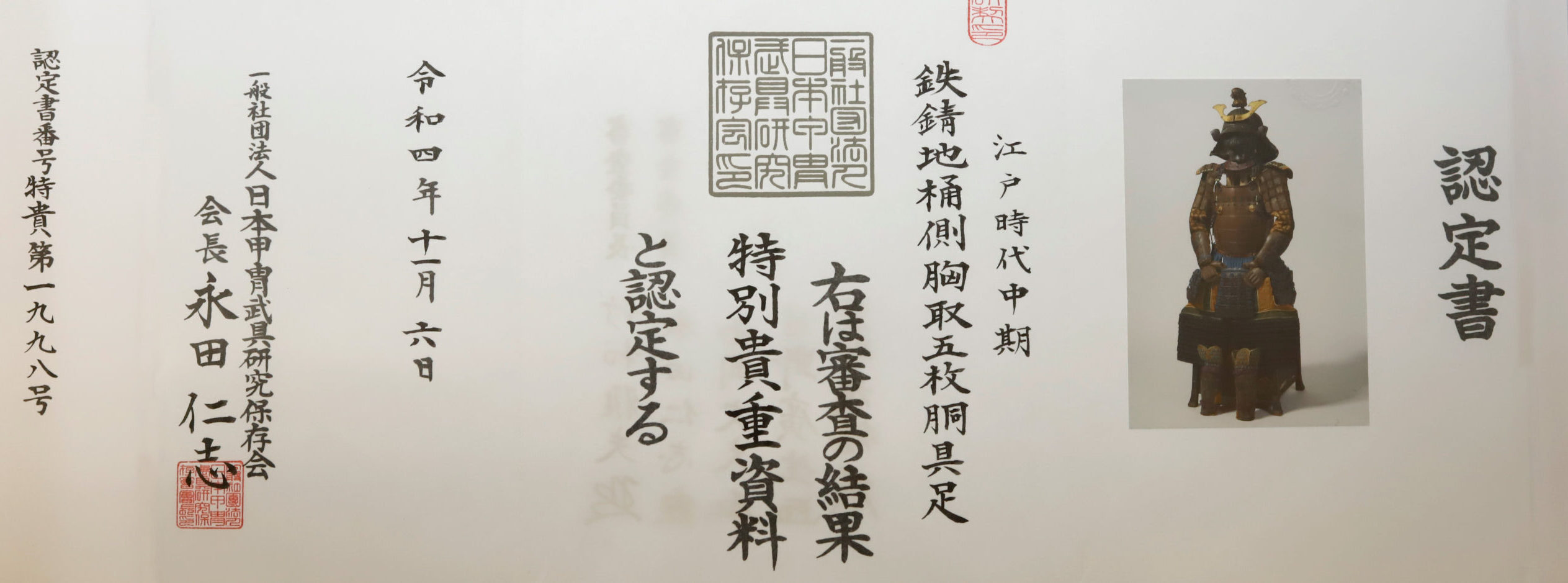
【About us】
Samurai Museum is located in Tokyo, Japan, exhibiting antique artifacts related to the Samurai history. Samurai Museum Shop is the place for those who are interested in Japanese culture and craftsmanship. We deal with antique Samurai swords/armor, traditional crafts made in Japan and so on.
【Antique Japanese Armor and Export process】
After receiving the full payment from you, we will apply for its export permit from the agency for Cultural Affairs to legally export the antique Samurai armor to other countries. It normally takes around 2-4 weeks to receive this permit. And we would like you to expect at least 1-1.5 months for your order to arrive at your given address after you ordered.
【Payment method】
We accept payment through Stripe (Credit card), PayPal, Apple Pay or ChromePay, all of which are secure payment methods. Also, you don’t need to make an account on Stripe for the checkout. If you prefer other payment method, please contact us. You may either pay in JPY, USD, AUD, CAD, EUR, CHF or GBP. The price is set in Japanese Yen. Prices in other currencies are automatically calculated based on the latest exchange rate.

【Shipping duration】
We normally ship via EMS (Express Mail Service) provided by Japan Post. It usually takes at least 5-14 days to deliver the package after you place an order. We offer Free International Shipping as long as we can ship your order by EMS. If you prefer other shipping carriers, please contact us.
We will inform you of the order’s tracking number via email. Please make sure you fill out your valid email address correctly.
*Please keep in mind that due to the spread of COVID-19, there might be possible delays in delivery. If you like to make sure if EMS shipping is available to your country, please contact us.

【How to make sure the condition】
Please keep in mind that what you are going to purchase is an antique item. We uploaded high resolution photos for you to check its condition thoroughly. If you like to see more photos with different angles, please feel free to contact us. We will be happy to send them to you so that you can make informed decision. It is essential for us to know that you are happy with your choice of a sword. and we are prepared to use the best of our ability to serve you.
【How To Contact Us】
Please contact us through email, Facebook Messenger or Live Chat if you have any questions. You can find each icon on the right side of the website. Please click one of them to reach us. We will reply to you within 1-2 business days.
【How To Preserve Antique Samurai Armor】
Dryness, humidity, and bad ventilation might deteriorate the condition of antique Samurai armor. The best temperature to preserve Samurai armor is around 20℃ in Celsius, and humidity should be about 60%. Direct sunlight should be avoided. We recommend storing armors in a room with good ventilation. If you like to display them outside the boxes for a prolonged time, we suggest using a glass case in order for dust not to be accumulated easily. In case you don’t use a glass case, please make sure to regularly dust off from the armor by using a soft brush made of delicate cloth or brush for painting.
If you like to know more about the preservation of this armor, please feel free to contact us.
